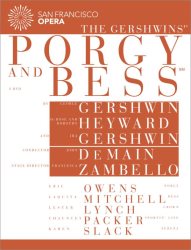| 
|
George GERSHWIN (1898-1937)
Porgy and Bess - Opera in two Acts (1935)
Lyrics by DuBose Heyward and Ira Gershwin.
Libretto by DuBose Heyward.
Porgy, a crippled beggar - Eric Owens (baritone); Bess - Laquita Mitchell
(soprano); Serena, Robbin’s wife - Inez Matthews (soprano); Sporting
Life, a dope pedlar – Chauncey Packer (tenor); Crown, a stevedore
- Lester Lynch (baritone); Jake, a fisherman - Eric Greene (baritone);
Clara, Jake’s wife - Angel Blue (soprano); Maria, keeper of the
cookshop - Alteouise de Vaughn (mezzo); Mingo - Michael Bragg (tenor)
San Francisco Opera Orchestra and Chorus/John DeMain
Directed by Francesca Zambello
Set designer: Peter J Davison
Costume Designer: Paul Tazewell
Picture format: 1080i Full HD - 16.9
Sound formats: PCM Stereo, DTS-HD Master Audio 5.1
rec. San Francisco Opera, June 2009.
Subtitles: English, German, French, Japanese, Korean
Booklet notes in English, German, French
EUROARTS DVD 2059638 [158:00 + 29:00 bonus]
Porgy and Bess, played here in its operatic version, has had a chequered history over many years. It could be described as lighter music’s answer to Verdi’s Don Carlos in that it was initially too long and ended up in multiple versions and revisions.
Premiered in Boston on 30 September 1935 Porgy and Bess was initially over four hours long. For its Broadway premiere ten days later over forty-five minutes had been cut. A second Broadway production in 1942 was cut even further and the sung recitatives had been replaced by spoken dialogue. Despite being considered non-U for a long period this was the favoured edition for over thirty-five years whenever it was staged. Despite efforts it never appeared at New York’s Metropolitan Opera during this period. It had grown up in the time of repression and segregation in southern USA. Many Afro-Americans, who Gershwin wanted to appear in the opera refused to do so, believing it demeaned the innate nobility of their call for equality. The Civil Rights movement brought about big changes. By the 1960s, black singers were common at the Met. Marian Anderson’s 1956 breakthrough as Ulrica in Verdi’s Un Ballo in Maschera presaged Leontyne Price's reign as house diva, with Martina Arroyo, Shirley Verrett and Grace Bumbry also leading lights there. It was in this period that Porgy and Bess re-emerged as an opera, perhaps assisted by the RCA recording. Houston Opera's seminal 1976 production also played its part and restored the material that had been excised in the second Broadway version. It toured the USA to acclaim. The Intendant at Houston, later ensconced in San Francisco, brought the production and conductor to his new home and this is it.
Do not think of Gershwin in terms only of musicals. Like his Rhapsody in Blue, jazz idioms are present. However, this is an opera, complete with humour, pathos, betrayal, sexual passion, betrayal, violent murder and tragedy; just like Don Carlos in fact. It reflects the composer’s long-held interest in the life experiences of Afro-Americans in the Deep South during the depression years of the 1930s. Regrettably, he did not live to see the acceptance of his work on the world’s lyric stages, dying a mere two years after its premiere.
Most of Porgy and Bess is set in a congested Afro-American ghetto in South Carolina called Catfish Row. The local trade is fishing. The sets and costumes are in period and realistic in size and appearance. Among the many residents in the multi-tiered apartments in this crowded domain lives Porgy, a crippled beggar. Bess, a very attractive local woman is owned by Crown, a local stevedore and a bit of a thug. She has sympathy with Porgy and in Crown’s absence takes up with him. Crown returns and demands she comes back to him. A fight follows and Crown is stabbed and killed by Porgy; nobody is exactly sorry. There is no happy ending although Porgy avoids prison; but I won’t spoil the story.
What is evident is quite a lot of physical type-casting. Crown is a very big guy. Sportin’ Life is the ultimate sly spiv junk pusher, complete with smart waistcoat. Bess, with her flaming red hair and nicely proportioned figure, is any man’s sex symbol. Then there is Eric Owens as Porgy. Good? Excellent is the word for the acting and singing of the rest of the cast, whilst Owens is quite outstanding in every aspect of his portrayal of the semi-outcast cripple who sees redemption and acceptance in the kindness and love of Bess. The many small roles are sung and acted without weakness and the well-known arias and chorus highlights are played with affection under John DeMain’s idiomatic and vibrant baton, the jazz rhythms are evident as is the inner complexity of the score.
As to presentation, the sound and picture quality is excellent. The bonus of interviews with the cast and conductor are of interest rather than mere filling. My comment regarding the similarity of Verdi’s Don Carlos and Porgy and Bess was not facile. The former was the Italian’s greatest creation as was this work in the case of Gershwin. Verdi lived to a ripe old age, changing the form and idiom of Italian opera in a fundamental way. Gershwin died tragically young. Had he lived the nature of American opera would, I suggest, have been very different.
Robert J Farr
 |
 |
|
